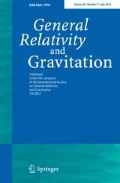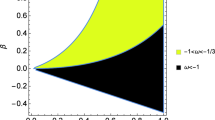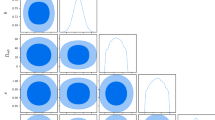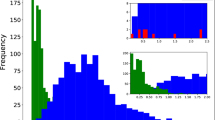Abstract
The cosmological model consisting of a nonlinear magnetic field obeying the Lagrangian \(\mathcal {L}= \gamma F^{\alpha },\, F\) being the electromagnetic invariant, coupled to a Robertson-Walker geometry is tested with observational data of Type Ia Supernovae, Long Gamma-Ray Bursts and Hubble parameter measurements. The statistical analysis show that the inclusion of nonlinear electromagnetic matter is enough to produce the observed accelerated expansion, with not need of including a dark energy component. The electromagnetic matter with abundance \(\varOmega _B\), gives as best fit from the combination of all observational data sets \(\varOmega _B=0.562^{+0.037}_{-0.038}\) for the scenario in which \(\alpha =-1, \varOmega _B=0.654^{+0.040}_{-0.040}\) for the scenario with \(\alpha =-1/4\) and \(\varOmega _B=0.683^{+0.039}_{-0.043}\) for the one with \(\alpha =-1/8\). These results indicate that nonlinear electromagnetic matter could play the role of dark energy, with the theoretical advantage of being a mensurable field.



Similar content being viewed by others
References
Novello, M., Perez Bergliaffa, S.E., Salim, J.: Phys. Rev. D 69, 127301 (2004). doi:10.1103/PhysRevD.69.127301
Novello, M., Goulart, E., Salim, J., Perez Bergliaffa, S.: Class. Quantum Gravity 24, 3021 (2007). doi:10.1088/0264-9381/24/11/015
Vollick, D.N.: Phys. Rev. D 78, 063524 (2008). doi:10.1103/PhysRevD.78.063524
Labun, L., Rafelski, J.: Phys. Rev. D 81, 065026 (2010). doi:10.1103/PhysRevD.81.065026
García-Salcedo, R., Gonzalez, T., Quiros, I.: Phys. Rev. D 89, 084047 (2014). doi:10.1103/PhysRevD.89.084047
Dyadichev, V., Gal’tsov, D., Zorin, A., Zotov, M.Y.: Phys. Rev. D 65, 084007 (2002). doi:10.1103/PhysRevD.65.084007
Elizalde, E., Lidsey, J.E., Nojiri, S., Odintsov, S.D.: Phys. Lett. B 574, 1 (2003). doi:10.1016/j.physletb.2003.08.074
Beltran Jimenez, J., Maroto, A.L.: Phys. Rev D 78, 063005 (2008). doi:10.1103/PhysRevD.78.063005
Beltran Jimenez, J., Maroto, A.L.: JCAP 0903, 016 (2009). doi:10.1088/1475-7516/2009/03/016
Beltran Jimenez, J., Maroto, A.L.: AIP Conf. Proc. 1122, 107 (2009). doi:10.1063/1.3141226
Medeiros, L.: Int. J. Mod. Phys. D 23, 1250073 (2012). doi:10.1142/S0218271812500733
Plebański, J.: Lectures on non-linear electrodynamics: an extended version of lectures given at the Niels Bohr Institute and NORDITA, Copenhagen, in October 1968 (NORDITA, 1970)
Mottola, E.: Proceedings of the XLVth Rencontres de Moriond, 2010 Cosmology, edited by E. Auge, J. Dumarchez and J. Tran Tranh an, The Gioi Publishers, Vietnam (2010)
Mosquera Cuesta, H.J., Salim, J.M., Novello, M.: (2007). arXiv: 0710.5188
Born, M., Infeld, L.: Proc. R. Soc. Lond. A 144, 425 (1934)
Tolman, R.C., Ehrenfest, P.: Phys. Rev. 36, 1791 (1930). doi:10.1103/PhysRev.36.1791
Armendariz-Picon, C.: JCAP 0407, 007 (2004). doi:10.1088/1475-7516/2004/07/007
Cembranos, J., Hallabrin, C., Maroto, A., Jareno, S.N.: Phys. Rev. D 86, 021301 (2012). doi:10.1103/PhysRevD.86.021301
Novello, M.: Int. J. Mod. Phys. A 20, 2421 (2005). doi:10.1142/S0217751X05024717
Lemoine, D., Lemoine, M.: Phys. Rev. D 52, 1955 (1995). doi:10.1103/PhysRevD.52.1955
Novello, M., Araujo, A.N., Salim, J.: Int. J. Mod. Phys. A 24, 5639 (2009). doi:10.1142/S0217751X09046321
Chayan Ranjit, U.D., Chakraborty, Shuvendu: Astrophys. Space Sci 346, 291 (2013). doi:10.1007/s10509-013-1441-2
Heisenberg, W., Euler, H.: Z. Phys. 38, 714 (1936)
Pagels, H., Tomboulis, E.: Nucl. Phys. B 143, 485 (1978). doi:10.1016/0550-3213(78)90065-2
Novello, M., Salim, J., Araujo, A.N.: Phys. Rev. D 85, 023528 (2012). doi:10.1103/PhysRevD.85.023528
Esposito-Farese, G., Pitrou, C., Uzan, J.P.: Phys. Rev. D 81, 063519 (2010). doi:10.1103/PhysRevD.81.063519
Golovnev, A., Klementev, A.: JCAP 1402, 033 (2014). doi:10.1088/1475-7516/2014/02/033
Sola, J., Stefancic, H.: Phys. Lett. B624, 147 (2005). doi:10.1016/j.physletb.2005.08.051
Caldwell, R.: Phys. Lett. B 545, 23 (2002). doi:10.1016/S0370-2693(02)02589-3
Ade, P., et al.: (2013). arXiv: 1303.5076
Suzuki, N., Rubin, D., Lidman, C., Aldering, G., Amanullah, R., et al.: Astrophys. J. 746, 85 (2012). doi:10.1088/0004-637X/746/1/85
Moresco, M., Verde, L., Pozzetti, L., Jimenez, R., Cimatti, A.: JCAP 1207, 053 (2012). doi:10.1088/1475-7516/2012/07/053
Jimenez, R., Loeb, A.: Astrophys. J. 573, 37 (2002). doi:10.1086/340549
Tsutsui, R., Nakamura, T., Yonetoku, D., Takahashi, K., Morihara, Y.: (2012). arXiv: 1205.2954
Kodama, Y., Yonetoku, D., Murakami, T., Tanabe, S., Tsutsui, R., Nakamura, T.: Mon. Not. R. Astron. Soc. 391, L1 (2008). doi:10.1111/j.1745-3933.2008.00508.x
Liang, N., Xiao, W.K., Liu, Y., Zhang, S.N.: Astrophys. J. 685, 354 (2008). doi:10.1086/590903
Wei, H., Zhang, S.N.: Eur. Phys. J. C 63, 139 (2009). doi:10.1140/epjc/s10052-009-1086-z
Wei, H.: JCAP 1008, 020 (2010). doi:10.1088/1475-7516/2010/08/020
Wang, Y.: Phys. Rev. D 78, 123532 (2008). doi:10.1103/PhysRevD.78.123532
Cardone, V.F., Capozziello, S., Dainotti, M.G.: Mon. Not. R. Astron. Soc. 400(2), 775 (2009). doi:10.1111/j.1365-2966.2009.15456.x
Mosquera Cuesta, H.J., H. Dumet M., Furlanetto, C.: JCAP 0807, 004 (2008). doi:10.1088/1475-7516/2008/07/004
Liang, N., Wu, P., Zhang, S.N.: Phys. Rev. D 81, 083518 (2010). doi:10.1103/PhysRevD.81.083518
Freitas, R., Goncalves, S., Velten, H.: Phys. Lett. B 703, 209 (2011). doi:10.1016/j.physletb.2011.07.070
Graziani, C.: New Astron. 16, 57 (2011). doi:10.1016/j.newast.2010.08.001
Collazzi, A.C., Schaefer, B.E., Goldstein, A., Preece, R.D.: Astrophys. J. 747, 39 (2012). doi:10.1088/0004-637X/747/1/39
Butler, N.R., Kocevski, D., Bloom, J.S.: Astrophys. J. 694(1), 76 (2009). doi:10.1088/0004-637X/694/1/76
Shahmoradi, A., Nemiroff, R.: Mon. Not. R. Astron. Soc. 411, 1843 (2011). doi:10.1111/j.1365-2966.2010.17805.x
Butler, N.R., Bloom, J.S., Poznanski, D.: Astrophys. J. 711, 495 (2010). doi:10.1088/0004-637X/711/1/495
Dunkley, J., Bucher, M., Ferreira, P.G., Moodley, K., Skordis, C.: Mon. Not. R. Astron. Soc. 356, 925 (2005). doi:10.1111/j.1365-2966.2004.08464.x
Berg, B.: Markov Chain Monte Carlo Simulations and Their Statistical Analysis: With Web-based Fortran Code. World Scientific, Singapore (2004)
MacKay, D.J.C.: Information Theory, Inference and Learning Algorithms. Cambrdige University Press, Cambrdige (2003)
Neal, R.M.: Probabilistic inference using markov chain monte carlo methods. Technical Report CRG-TR-93-1, Department of Computer Science, University of Toronto (1993)
Riess, A.G., Macri, L., Casertano, S., Lampeitl, H., Ferguson, H.C., et al.: Astrophys. J. 730, 119 (2011). doi:10.1088/0004-637X/730/2/119
Acknowledgments
A. M. acknowledges financial support from CONACyT (Mexico) through a Ph.D. Grant. N. B. acknowledges partial support by Conacyt, Project 166581. We also acknowledge to the anonymous referee whose suggestions lead to improve our work.
Author information
Authors and Affiliations
Corresponding author
Appendices
Appendix 1: Scaling between the scale factor \(a\) and the electromagnetic invariant \(F\)
The energy conservation \(T_{;\mu }^{\mu \nu } = 0\), leads to the equation
which also can be derived from Eq. (6). So, using the expressions of \(\rho \) and \(p\), Eq. (2), in terms of the electromagnetic Lagrangian, the scaling between the scale factor \(a\) and the electromagnetic invariant \(F\) can be determined for a Lagrangian with arbitrary dependence on the two electromagnetic invariants \(\mathcal {L}(F,G)\) as
Now, if one restricts to the case \(G=0\) (i.e. no electric field \(E=0\)), then \(F=2B^2\) and
whose solution, given by \(Fa^4=\mathrm{const}\), is independent of the particular form of \(\mathcal {L}(F)\).
Appendix 2: The scale factor as a function of time
The expressions of Friedmann equations for the nonlinear magnetic terms are
Knowing that \(\mathcal {L}a^{4 \alpha }=\mathrm{const}\), and using the Friedmann equations, the expression for \(a(t)\) can be determined. Let us consider the following derivative,
and substituting Friedmann’s equation, Eq. (25), we realize that the right hand term is constant,
Finally, integrating for \(a(t)\), it is obtained that \(a(t)= \mathrm{const}(t-t_0)^{1/2 \alpha }\).
Rights and permissions
About this article
Cite this article
Montiel, A., Bretón, N. & Salzano, V. Parameter estimation of a nonlinear magnetic universe from observations. Gen Relativ Gravit 46, 1758 (2014). https://doi.org/10.1007/s10714-014-1758-3
Received:
Accepted:
Published:
DOI: https://doi.org/10.1007/s10714-014-1758-3




